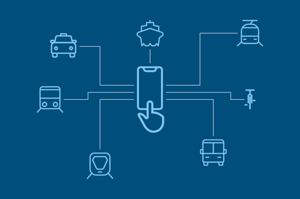Over ten years ago, when Apple introduced the first ever iPhone they also coined the phrase: “there’s an app for that.” You’ve no doubt heard this phrase a million times before. In fact, it exploded in popularity so much that Apple decided to get the slogan trademarked to prevent other businesses from using it in their marketing collateral.
This was a smart move by the tech company, considering that now there really is an app for absolutely everything - and more recently there seems to be apps that do the jobs of many. For example, JustEat allows people to order from any local takeaway in their area.
And SkyScanner lets savvy jetsetters compare the prices of multiple airlines with one click.
With apps like these already at our fingertips, it’s only a matter of time before we have one app that covers all public transport options.
With every year that passes, our lives are becoming ever more intertwined with technology. And, as populations in urban areas continue to boom, there is a desperate need for public transport to be more efficient for the modern customer of today.
In this article, we’re going to look at how connecting different services through technology can improve public transport.
What is Mobility-as-a-Service?
Put simply, mobility-as-a-service (MaaS) is the integration of all transport options (from taxis to rail services - regardless of provider) into a single app. An ideal MaaS app will also include everything from Journey Planner to payment options.
It may sound too good to be true, but in some cities mobility-as-a-service is already a reality.
The first commercial implementation of MaaS was in Helsinki, Finland, in 2016. The app, called Whim, is now also available in Antwerp, Birmingham, and Vienna. And, MaaS Global (the company behind the intuitive app) is soon to launch it in America, too.
Whim offers users an all-inclusive package, allowing customers to plan and pay for public transport - such as bike and scooter rentals, rail services, taxis, car rentals, and even ridesharing - in one, easy-to-use platform.
Users of the app are free to book everything on a pay-as-you-go basis, if they don’t use public transport that often, or by a monthly subscription that covers all services.
So far, 3 million trips have been booked through the Whim app since it was launched!
MaaS in Action
Although Whim was the first MaaS app - and is still definitely the most comprehensive - there are other apps emerging that are making waves in the mobility industry.
-
TripGo
TripGo allows users to compare and combine transport modes to find the best route for them, whether that’s the quickest or the most cost-effective.
This ability to combine different modes of transport is what makes TripGo stand out. By combining things like bike hire, trams, and even ferries, the app can help users plan their entire trip, from door to door.
Other notable features include the ability to check fare prices and get real-time updates on departure and arrival times.
The app is currently available in around 200 locations worldwide, and users can connect it to their phone calendar to set reminders and effectively plan their trips.
-
Moovit
Moovit combines all local transit information into one place. This helps users to find out crucial information about nearby stations, including what platform they need to be on and when the last ride of the night is going to depart.
Users can’t yet pay for transport within the app, but they can find directions, get notified about arrivals and departures in real-time, and also utilise ‘get off’ alerts - so they never miss their stop!
The app is can enable location use, so it can be used for directions. And users can even tag their favourite locations in one-tap, for easier access next time they travel there.
-
Viago
Although not a fully-fledged MaaS app yet, Viago acts as a link between transport apps and their customers.
Similar to the way JustEat lists all local takeaways in one place, and SkyScanner lists all airlines, Viago lists all transport options - such as Lyft, Uber - so that customers can compare them in one window, making their lives easier.
This app is currently only available in Belgium, but who knows where it will travel to in the future!
The Future of Mobility-as-a-Service
This is just the beginning for MaaS. In the future, transport services will be more connected, and MaaS apps will make it convenient for customers all over the world to plan, and pay for, their transport all in one place.
One solution on the horizon is Switch. Switch is set to launch in the US soon and will be the first app to integrate real-time, micro-transit ride generation capability. According to John E. Michel, Managing Partner of Switch Mobility:
“Switch will help to make current and emerging transportation options more accessible, all while reducing car ownership and congestion.”
This marks an encouraging step towards more sustainable, greener, smart cities .
Final Thoughts
Public transport was once one of the most innovative industries in the world, but has since become stagnant. With new mobility-as-a-service apps emerging and evolving, and more on the horizon, the future of public transport has never looked brighter.
To find out more about how the future of public transport can be improved for everyone, download our free eBook: Public Transport: The Key to a Smart, Safe and Sustainable Future.
See the full range of Metro & Public Transport Security Solutions from Gunnebo here!



